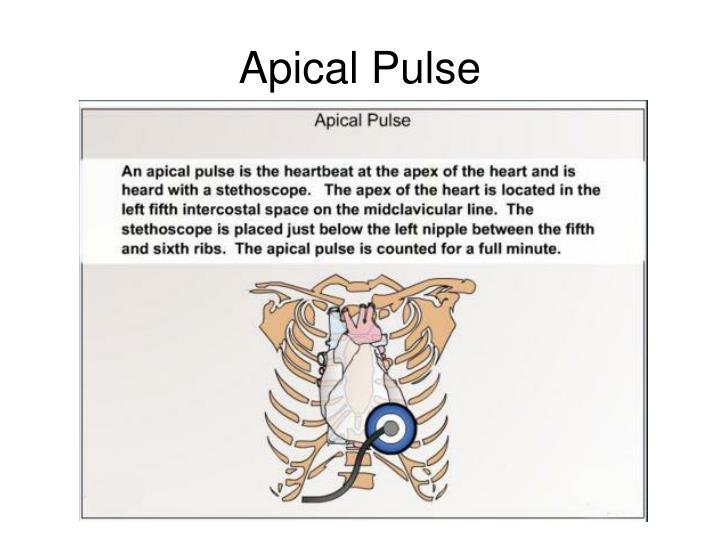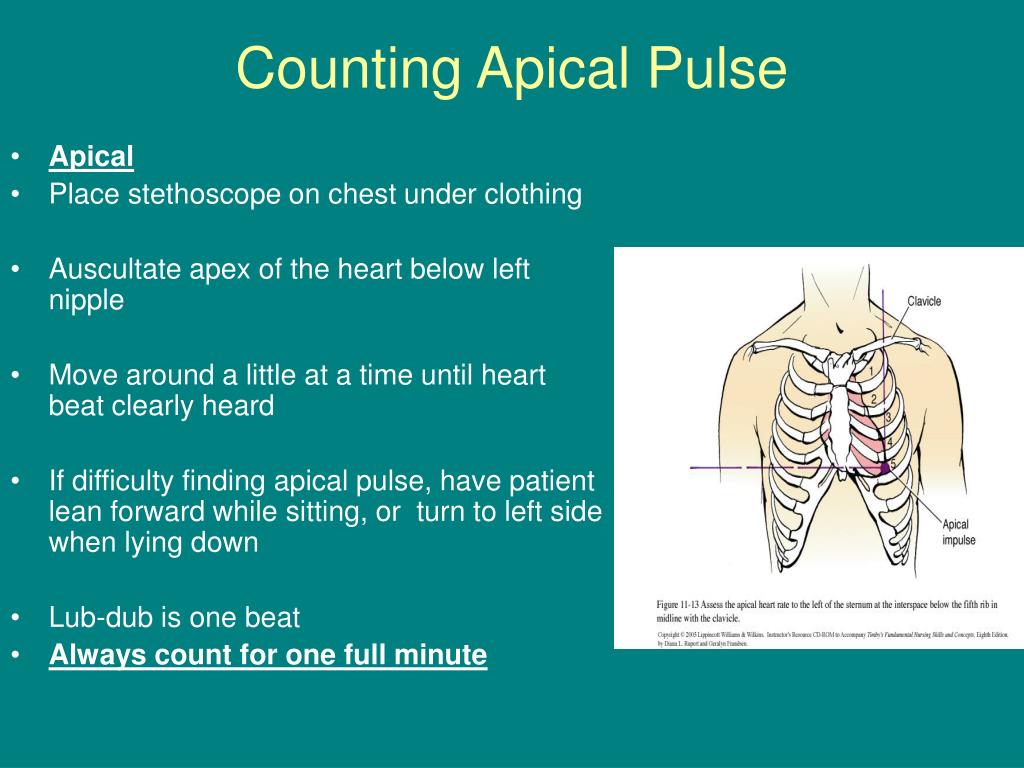
10 the point of maximal impulse (PMI, or apical. The apex beat or apical impulse is the palpable cardiac impulse farthest away from the sternum and farthest down on the chest wall, usually caused by the LV. OR doing it in a crowded noisy place.or when a patient won't be quiet.or when you have lots of wheezes or rales.or a screaming child.or if you are interested in ambulance ride alongs any time soon.LOL, "what does the apical heart sound like?" "oh.a diesel engine!".LOL! Don't worry.you will get it.I practiced on myself and my loved ones.boy did that help! (I have PAC or Pre Atrial Contractions.short of it.my heart skips and beats to its own wierd rhythm when stressed.boy I was the MOST popular heart sound gal in school.LOL "hey Triage.can I hear your PAC's?" LOL!!!!!!). Help the patient into a supine or sitting position, and expose the sternum and the left side of the chest.
#Apical pulse location how to
Just an addition, finding this with larger breasted men or women can be an intesting endevor.you will learn how to by doing it :)! Finally, wipe the stethoscope clean and practice hand hygiene.The apical pulse is the pulse heard at the apex of the heart (which is the pointed lower extremity of the heart) Yoou can hear the apical pulse by placing your stethescope at the 5th intercostal space (spaces between the ribs) on the left side just left of the sternum. Take the stethoscope off the clients' chest, adjust the head of the bed, and assist them back into a suitable position.Begin counting the heartbeats for one minute. You should now hear something that sounds like lub dub, lub dub, lub dub, which repeats over and over again. Once you hear the tap, place your stethoscope against the client's apical pulse. If you don't hear the tap, turn the chest piece at the tubing. A medical assistant may be asked to take the patients apical pulse, which is the most accurate non-invasive. After that, put the earpieces in your ears. Medical Assisting Clinical Skills - Apical Pulse. Ventricular contraction causes the left ventricle to move both downward and laterally (.


It can be felt at the top of the rib cage. Palpate apical pulse for location -With the patient in sitting position, palpate over the apex of the heart at the 5th ICS, LMCL, using your fingertips -if the PMI cannot be palpated in this position, repeat the procedure with the patient lying supine and also on the leftside Auscultate S1 and S2 heart sounds for rate, rhythm ,pitch. As the right ventricle enlarges, it may cause the apical impulse. This is the location of the apex of the heart. The clavicle is also called the collarbone. Place the bell of the stethoscope at the fifth intercostal space, at the left midclavicular line. In healthy people this is roughly located at the left mid-clavicular. Feel the first rib by finding the clavicle. A pulse felt or heard over the part of the chest wall that lies over the apex of the heart. To take the apical pulse, you will need to access the bare chest.

The apex of the heart is on the left side of the chest in a healthy individual and the heart. That's usually just below the left nipple or under the breast. Apical pulse is also known as point of maximum pulse or PMI.

The location of a murmur indicates the anatomical origin of the turbulent blood flow, while the timing of the murmur indicates the functional mechanism by which the turbulence is generated. If tolerated by the client, lift the head of the bed and assist the client to a sitting position. If murmur gets softer, the location of the murmur is apical if murmur gets louder, the location is at the base.This position roughly corresponds to the lower (pointed) end. It can be found in the left center of your chest, just below the nipple. Once again, start by practicing hand hygiene. The apical pulse is one of eight common arterial pulse sites. Obtaining an apical pulse is the most reliable and accurate way to measure the pulse.įirst, gather the supplies you'll need, including: The apical pulse is the pulse that's felt right over the heart.


 0 kommentar(er)
0 kommentar(er)
